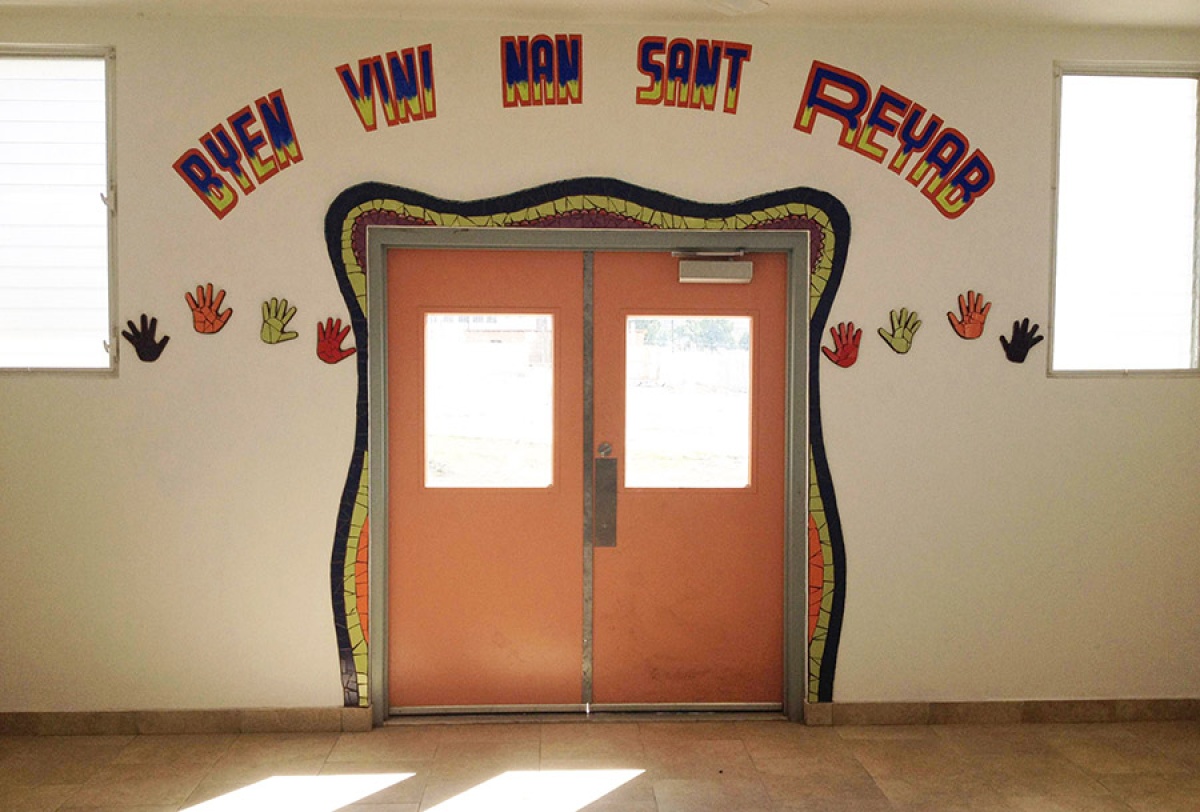Haiti: Mosaics to Bring Inspiration, Hope to Rehab Patients
Posted on Mar 26, 2015

Andree LeRoy looked around University Hospital’s new Center of Excellence in Rehab and Education in Mirebalais, Haiti, and felt a growing sense of pride. The center—the first of its kind within the country’s public sector—is the physical manifestation of a dream she’s had since coming to work in Haiti as a physiatrist and Partners In Health/Zanmi Lasante’s director of rehabilitation services. Scheduled to open in June, the L-shaped facility will house a gym and 10 beds for patients embarking on the long, but ultimately rewarding, journey that is rehabilitation.
While LeRoy loved the new space, she and her colleagues knew something was missing. The white-washed walls lacked warmth and a sense of home.
University Hospital’s mission “is to really create a dignified space for people to recover,” LeRoy said. “We know for people who’ve acquired a disability, they’re devastated. And we know how important the marriage of art and medicine is.”
Looking around University Hospital, it’s clear the facility’s founders believe that environment is key to a successful recovery. Colorful, complex mosaics grace the hospital’s entrance, transform the hospital’s logo, decorate a wall of benches by the emergency department, and enliven the entire pediatrics ward. All were completed by Laurel True, a New Orleans-based mosaic artist and founder of True Mosaics Studio, and her team of Haitian artists, the Mirebalais Mosaic Collective (MMC).
True met Dr. Paul Farmer, a PIH co-founder and chief strategist, in the Miami International Airport on her way home from her first trip to Haiti, where she worked with children in Jacmel to create an earthquake memorial. Farmer suggested she come to University Hospital and took her business card. Within 24 hours, she was in touch with PIH staff to plan the first mosaic.
“Having a creative component and having visual art included in healing spaces is vastly important,” True said. “And PIH has really shared that value of bringing beauty, a dignified healing space, and a more holistic perspective on healing and well-being.”
LeRoy and Jonah Feldman, a physical therapist and the rehabilitation program’s clinical manager, were impressed by the way True and the MMC transformed University Hospital, so they asked the artists to help beautify the center. True “was instantly on board,” Feldman said.
The only remaining obstacle was funding. Feldman had heard about Kickstarter as a creative way to crowd-source, and had even donated once to a project based in South Africa, so he thought, “Why not Haiti?” He set up a page on the site and collaborated with LeRoy to create a short promotional video. They told potential funders their goal was to create “a space full of vibrant tile mosaic murals and a healing outdoor courtyard to provide a dignified, beautiful, and tranquil environment for our patients to aid in their recovery,” according to the site. “We are hoping to have images and scenes that represent inspiration, strength, and hope to help our patients on their journey of healing.”
Their $30,000 campaign launched in September 2014 and, with 212 supporters in 33 days, they exceeded their goal by more than $2,000.
With funding secured, Leroy, Feldman, and their Haitian coworkers and patients dove into developing concepts for the mosaics. They agreed the work should be “based on a marriage between the Haitian culture and the science” of rehabilitation, LeRoy said. Creole proverbs were the perfect vehicle to achieve that goal, and the group decided on two that directly applied to the hard work of rehabilitation: Piti piti zwazo fè nich li, or “Little by little the bird builds its nest,” and Men anpil chay pa lou, or “Many hands make the load lighter.” The first would feature a tree in whose branches nested a native bird, and the second would be of many hands lifting a basket filled with fruits and vegetables.
Two other murals would bring Haiti’s natural environment into the center—one depicted a sunset splitting a mountainscape, while the other was of Sodo waterfall, which Haitians visit because of its waters’ alleged healing powers. “The same way the waterfall is regenerating itself is the same way we want these patients to work on their regeneration,” LeRoy said.
True sketched the group’s ideas on a pad, further developed the designs, and later transferred them to the center’s walls. True, her student intern Randy Sanders, and the MMC worked for a week, and then MMC’s manager and lead production assistant, Mario Jeudi, and his team took it from there, snipping ceramic tiles into varying sizes and cementing them into radiant patterns within True’s design. They even trained patients in the art, giving the project a truly communal feel.
The team—who included Osner Jean Louis, Denis Bolivard, Cassius Smith, and Johnsky Chrispin—started on New Year’s Day and finished most of the work within three weeks. A Haitian artist then painted on the proverbs.
Feldman said the center now feels less sterile and more like a place filled with energy and vibrancy. “There’s a sense of moving forward and hope, of improving your function and your quality of life,” he said.
That used to be a foreign concept in a place like Haiti, LeRoy said. Most people who acquired a disability were considered a kokobe, a Creole derogatory term meaning a broken body or a broken mind, and treated as if their active life had ended. Because of the physical transformation patients have undergone at University Hospital and Zanmi Lasante sites nationwide, the Haitian medical community is beginning to understand the power of rehabilitation. That lesson will continue to be driven home in a colorful, vibrant new space.
The mosaics will send patients the message that “you’re not a castaway,” LeRoy said. “You are just as important in society as anyone else. The way to do that is to create a beautiful space.”
Consider that mission accomplished.
Click left and right buttons to view slideshow:













